PEG-40氢化蓖麻油 美国药典标准
peg-40氢化蓖麻油的合成方法

一、概述peg-40氢化蓖麻油是一种常用的有机化合物,广泛应用于化妆品、药品等领域。
其合成方法对其质量和性能具有重要影响。
本文将介绍peg-40氢化蓖麻油的合成方法,包括原料准备、反应条件、合成步骤等内容,以期为相关领域的研究和应用提供参考。
二、原料准备1. 蓖麻油:蓖麻油是peg-40氢化蓖麻油的原料之一,可通过蓖麻籽的压榨或提取得到。
2. 氢气:氢气是氢化蓖麻油反应中的重要原料,需纯度高。
3. 催化剂:常用的催化剂有铂、钯等,需按照一定比例配置。
三、合成步骤1. 氢化反应:将蓖麻油与适量的催化剂置于反应釜中,通入氢气,在一定温度和压力下进行氢化反应,直至反应结束。
2. 过滤分离:将反应液过滤,将固体残渣去除,得到氢化后的蓖麻油溶液。
3. 乳化处理:将氢化后的蓖麻油溶液与适量的乳化剂混合,经过一定工艺处理,得到peg-40氢化蓖麻油。
四、反应条件1. 温度:氢化反应一般在60-80摄氏度进行,不宜过高或过低,以避免副反应的发生。
2. 压力:通入氢气的压力也是影响反应的重要因素,一般在1-5MPa之间。
3. 催化剂使用量:催化剂的使用量要严格控制在一定范围内,过多或过少都会影响反应效果。
五、产品性能测试1. 外观检查:peg-40氢化蓖麻油应为无色或微黄色液体,无异物悬浮。
2. 化学成分测试:通过核磁共振、质谱等分析手段,确认其化学成分符合要求。
3. 功能性能测试:包括乳化性能、稳定性、渗透性等指标的测试,以评价其在化妆品、药品等领域的应用性能。
六、结论peg-40氢化蓖麻油是一种重要的有机化合物,在化妆品、药品等领域有着广泛的应用。
其合成方法对其质量和性能具有重要影响。
本文介绍了peg-40氢化蓖麻油的合成方法,包括原料准备、合成步骤、反应条件等内容,并强调了产品性能测试的重要性。
期望本文能为相关领域的研究和应用提供参考,推动相关工作的进展与发展。
七、改进与优化1. 反应条件的优化:针对合成过程中的温度、压力和催化剂使用量等反应条件,可以通过实验设计和反应动力学研究,寻求最佳的工艺条件,以提高合成效率和降低成本。
蓖麻油质量标准
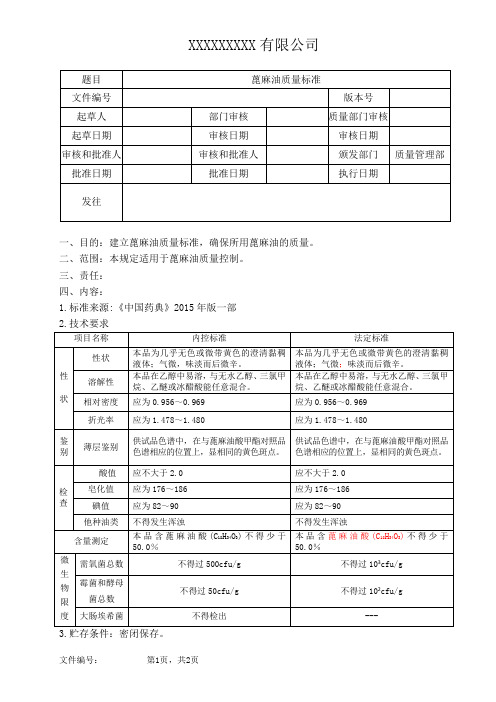
XXXXXXXXX有限公司
一、目的:建立蓖麻油质量标准,确保所用蓖麻油的质量。
二、范围:本规定适用于蓖麻油质量控制。
三、责任:
四、内容:
1.标准来源:《中国药典》2015年版一部
2.技术要求
3.贮存条件:密闭保存。
蓖麻油质量标准版本号:
4.相关标准操作规程:蓖麻油检验标准操作规程(SOP-ZL-JG(FL)-036)、物料取样标准操作规程(SOP-ZL-QA-001)。
5.企业统一指定的物料名称:与《中国药典》2015年版一部一致
6.内部使用的物料代码:1102054。
7.经批准的供应商:见合格供应商目录。
8.印刷包装材料的实样或样稿:无此项内容。
9.注意事项:密闭。
10.有效期:按厂家规定执行。
11.文件附件:共0份。
12.修订及变更历史:。
氢化蓖麻油
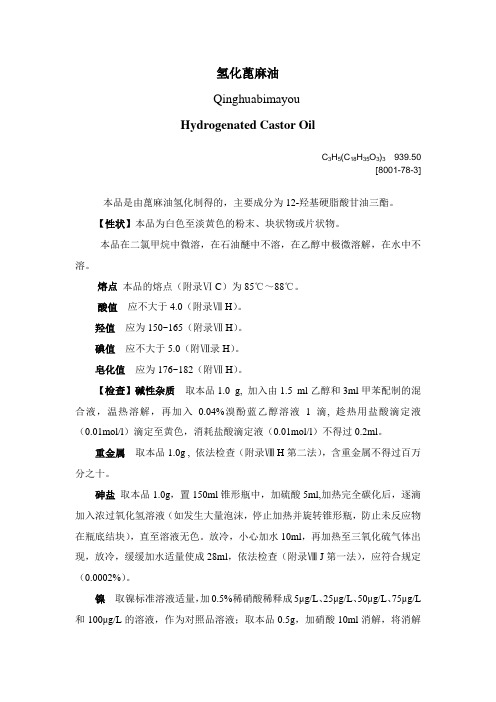
氢化蓖麻油QinghuabimayouHydrogenated Castor OilC3H5(C18H35O3)3939.50[8001-78-3]本品是由蓖麻油氢化制得的,主要成分为12-羟基硬脂酸甘油三酯。
【性状】本品为白色至淡黄色的粉末、块状物或片状物。
本品在二氯甲烷中微溶,在石油醚中不溶,在乙醇中极微溶解,在水中不溶。
熔点本品的熔点(附录Ⅵ C)为85℃~88℃。
酸值应不大于4.0(附录Ⅶ H)。
羟值应为150~165(附录Ⅶ H)。
碘值应不大于5.0(附Ⅶ录H)。
皂化值应为176~182(附Ⅶ H)。
【检查】碱性杂质取本品1.0 g, 加入由1.5 ml乙醇和3ml甲苯配制的混合液,温热溶解,再加入0.04%溴酚蓝乙醇溶液1滴, 趁热用盐酸滴定液(0.01mol/l)滴定至黄色,消耗盐酸滴定液(0.01mol/l)不得过0.2ml。
重金属取本品1.0g , 依法检查(附录Ⅷ H第二法),含重金属不得过百万分之十。
砷盐取本品1.0g,置150ml锥形瓶中,加硫酸5ml,加热完全碳化后,逐滴加入浓过氧化氢溶液(如发生大量泡沫,停止加热并旋转锥形瓶,防止未反应物在瓶底结块),直至溶液无色。
放冷,小心加水10ml,再加热至三氧化硫气体出现,放冷,缓缓加水适量使成28ml,依法检查(附录Ⅷ J第一法),应符合规定(0.0002%)。
镍取镍标准溶液适量,加0.5%稀硝酸稀释成5μg/L、25μg/L、50μg/L、75μg/L 和100μg/L的溶液,作为对照品溶液;取本品0.5g,加硝酸10ml消解,将消解后的液体转移至25ml容量瓶中,用水冲洗消解瓶2次,每次2ml,合并洗液,加入基体改进剂0.04mol/L硝酸镁溶液及0.87mol/L磷酸二氢铵溶液各1ml,加水稀释至刻度得供试液。
同法不加样品制备空白供试液,照原子吸收分光光度法(附录IV D 第一法),在232.0nm波长处测定,应符合规定(0.0005%)。
《中国药典》2020版—聚氧乙烯(40)氢化蓖麻油—羟丙甲纤维素国家药用辅料标准
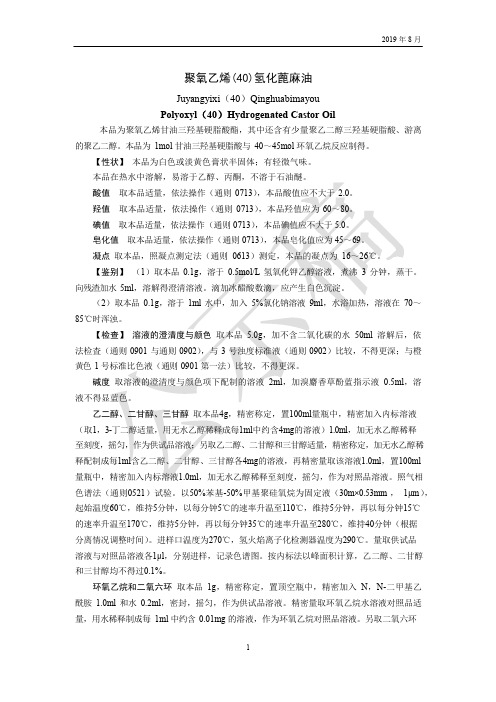
聚氧乙烯(40)氢化蓖麻油Juyangyixi(40)QinghuabimayouPolyoxyl(40)Hydrogenated Castor Oil本品为聚氧乙烯甘油三羟基硬脂酸酯,其中还含有少量聚乙二醇三羟基硬脂酸、游离的聚乙二醇。
本品为1mol 甘油三羟基硬脂酸与40~45mol 环氧乙烷反应制得。
【性状】本品为白色或淡黄色膏状半固体;有轻微气味。
本品在热水中溶解,易溶于乙醇、丙酮,不溶于石油醚。
酸值取本品适量,依法操作(通则0713),本品酸值应不大于2.0。
羟值取本品适量,依法操作(通则0713),本品羟值应为60~80。
碘值取本品适量,依法操作(通则0713),本品碘值应不大于5.0。
皂化值取本品适量,依法操作(通则0713),本品皂化值应为45~69。
凝点取本品,照凝点测定法(通则0613)测定,本品的凝点为16~26℃。
【鉴别】(1)取本品0.1g,溶于0.5mol/L 氢氧化钾乙醇溶液,煮沸3 分钟,蒸干。
向残渣加水5ml,溶解得澄清溶液。
滴加冰醋酸数滴,应产生白色沉淀。
(2)取本品0.1g,溶于1ml 水中,加入5%氯化钠溶液9ml,水浴加热,溶液在70~85℃时浑浊。
【检查】溶液的澄清度与颜色取本品 5.0g,加不含二氧化碳的水50ml 溶解后,依法检査(通则0901 与通则0902),与3 号浊度标准液(通则0902)比较,不得更深;与橙黄色1 号标准比色液(通则0901 第一法)比较,不得更深。
碱度取溶液的澄清度与颜色项下配制的溶液2ml,加溴麝香草酚蓝指示液0.5ml,溶液不得显蓝色。
乙二醇、二甘醇、三甘醇取本品4g,精密称定,置100ml量瓶中,精密加入内标溶液(取1,3-丁二醇适量,用无水乙醇稀释成每1ml中约含4mg的溶液)1.0ml,加无水乙醇稀释至刻度,摇匀,作为供试品溶液;另取乙二醇、二甘醇和三甘醇适量,精密称定,加无水乙醇稀释配制成每1ml含乙二醇、二甘醇、三甘醇各4mg的溶液,再精密量取该溶液1.0ml,置100ml量瓶中,精密加入内标溶液1.0ml,加无水乙醇稀释至刻度,摇匀,作为对照品溶液。
美国药典——精选推荐
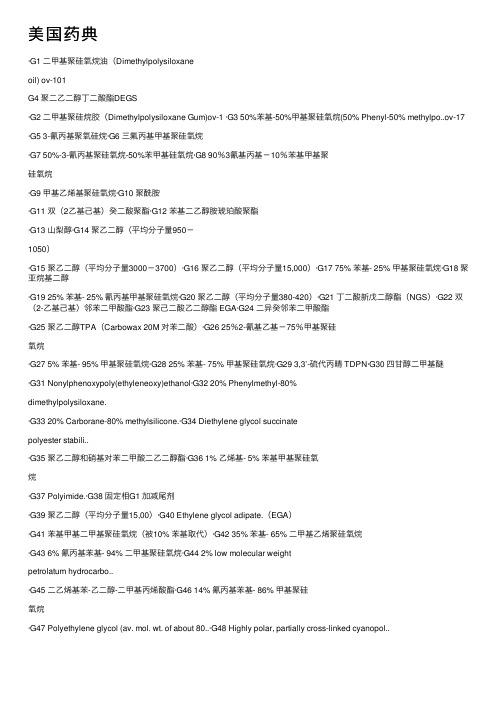
美国药典·G1 ⼆甲基聚硅氧烷油(Dimethylpolysiloxaneoil) ov-101G4 聚⼆⼄⼆醇丁⼆酸酯DEGS·G2 ⼆甲基聚硅烷胶(Dimethylpolysiloxane Gum)ov-1 ·G3 50%苯基-50%甲基聚硅氧烷(50% Phenyl-50% methylpo..ov-17·G5 3-氰丙基聚氧硅烷·G6 三氟丙基甲基聚硅氧烷·G7 50%-3-氰丙基聚硅氧烷-50%苯甲基硅氧烷·G8 90%3氰基丙基-10%苯基甲基聚硅氧烷·G9 甲基⼄烯基聚硅氧烷·G10 聚酰胺·G11 双(2⼄基⼰基)癸⼆酸聚酯·G12 苯基⼆⼄醇胺琥珀酸聚酯·G13 ⼭梨醇·G14 聚⼄⼆醇(平均分⼦量950-1050)·G15 聚⼄⼆醇(平均分⼦量3000-3700)·G16 聚⼄⼆醇(平均分⼦量15,000)·G17 75% 苯基- 25% 甲基聚硅氧烷·G18 聚亚烷基⼆醇·G19 25% 苯基- 25% 氰丙基甲基聚硅氧烷·G20 聚⼄⼆醇(平均分⼦量380-420)·G21 丁⼆酸新戊⼆醇酯(NGS)·G22 双(2-⼄基⼰基)邻苯⼆甲酸酯·G23 聚⼰⼆酸⼄⼆醇酯 EGA·G24 ⼆异癸邻苯⼆甲酸酯·G25 聚⼄⼆醇TPA(Carbowax 20M 对苯⼆酸)·G26 25%2-氰基⼄基-75%甲基聚硅氧烷·G27 5% 苯基- 95% 甲基聚硅氧烷·G28 25% 苯基- 75% 甲基聚硅氧烷·G29 3,3’-硫代丙晴 TDPN·G30 四⽢醇⼆甲基醚·G31 Nonylphenoxypoly(ethyleneoxy)ethanol·G32 20% Phenylmethyl-80%dimethylpolysiloxane.·G33 20% Carborane-80% methylsilicone.·G34 Diethylene glycol succinatepolyester stabili..·G35 聚⼄⼆醇和硝基对苯⼆甲酸⼆⼄⼆醇酯·G36 1% ⼄烯基- 5% 苯基甲基聚硅氧烷·G37 Polyimide.·G38 固定相G1 加减尾剂·G39 聚⼄⼆醇(平均分⼦量15,00)·G40 Ethylene glycol adipate.(EGA)·G41 苯基甲基⼆甲基聚硅氧烷(被10% 苯基取代)·G42 35% 苯基- 65% ⼆甲基⼄烯聚硅氧烷·G43 6% 氰丙基苯基- 94% ⼆甲基聚硅氧烷·G44 2% low molecular weightpetrolatum hydrocarbo..·G45 ⼆⼄烯基苯-⼄⼆醇-⼆甲基丙烯酸酯·G46 14% 氰丙基苯基- 86% 甲基聚硅氧烷·G47 Polyethylene glycol (av. mol. wt. of about 80..·G48 Highly polar, partially cross-linked cyanopol..。
2020版中国药典—聚氧乙烯(40)氢化蓖麻油国家药用辅料标准

聚氧乙烯(40)氢化蓖麻油Polyoxyl(40)Hydrogenated Castor Oil本品为聚氧乙烯甘油三羟基硬脂酸酯,其中还含有少量聚乙二醇三羟基硬脂酸、游离的聚乙二醇。
本品为1mol 甘油三羟基硬脂酸与40~45mol 环氧乙烷反应制得。
【性状】本品为白色或淡黄色膏状半固体;有轻微气味。
本品在热水中溶解,易溶于乙醇、丙酮,不溶于石油醚。
酸值取本品适量,依法操作(通则0713),本品酸值应不大于2.0。
羟值取本品适量,依法操作(通则0713),本品羟值应为60~80。
碘值取本品适量,依法操作(通则0713),本品碘值应不大于5.0。
皂化值取本品适量,依法操作(通则0713),本品皂化值应为45~69。
凝点取本品,照凝点测定法(通则0613)测定,本品的凝点为16~26℃。
【鉴别】(1)取本品0.1g,溶于0.5mol/L 氢氧化钾乙醇溶液,煮沸3 分钟,蒸干。
向残渣加水5ml,溶解得澄清溶液。
滴加冰醋酸数滴,应产生白色沉淀。
(2)取本品0.1g,溶于1ml 水中,加入5%氯化钠溶液9ml,水浴加热,溶液在70~85℃时浑浊。
【检查】溶液的澄清度与颜色取本品 5.0g,加不含二氧化碳的水50ml 溶解后,依法检査(通则0901 与通则0902),与3 号浊度标准液(通则0902)比较,不得更深;与橙黄色1 号标准比色液(通则0901 第一法)比较,不得更深。
碱度取溶液的澄清度与颜色项下配制的溶液2ml,加溴麝香草酚蓝指示液0.5ml,溶液不得显蓝色。
乙二醇、二甘醇、三甘醇取本品4g,精密称定,置100ml量瓶中,精密加入内标溶液(取1,3-丁二醇适量,用无水乙醇稀释成每1ml中约含4mg的溶液)1.0ml,加无水乙醇稀释至刻度,摇匀,作为供试品溶液;另取乙二醇、二甘醇和三甘醇适量,精密称定,加无水乙醇稀释配制成每1ml含乙二醇、二甘醇、三甘醇各4mg的溶液,再精密量取该溶液1.0ml,置100ml量瓶中,精密加入内标溶液1.0ml,加无水乙醇稀释至刻度,摇匀,作为对照品溶液。
药用级PEG40氢化蓖麻油聚氧乙烯优点
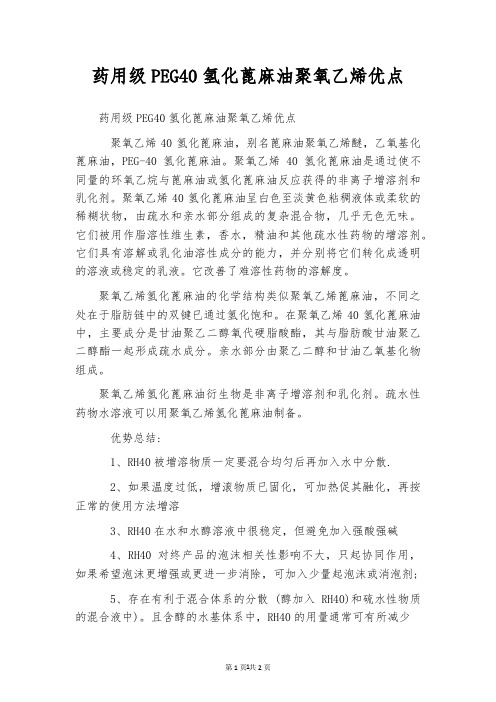
药用级PEG40氢化蓖麻油聚氧乙烯优点药用级PEG40氢化蓖麻油聚氧乙烯优点聚氧乙烯40氢化蓖麻油,别名蓖麻油聚氧乙烯醚,乙氧基化蓖麻油,PEG-40氢化蓖麻油。
聚氧乙烯40氢化蓖麻油是通过使不同量的环氧乙烷与蓖麻油或氢化蓖麻油反应获得的非离子增溶剂和乳化剂。
聚氧乙烯40氢化蓖麻油呈白色至淡黄色粘稠液体或柔软的稀糊状物,由疏水和亲水部分组成的复杂混合物,几乎无色无味。
它们被用作脂溶性维生素,香水,精油和其他疏水性药物的增溶剂。
它们具有溶解或乳化油溶性成分的能力,并分别将它们转化成透明的溶液或稳定的乳液。
它改善了难溶性药物的溶解度。
聚氧乙烯氢化蓖麻油的化学结构类似聚氧乙烯蓖麻油,不同之处在于脂肪链中的双键已通过氢化饱和。
在聚氧乙烯40氢化蓖麻油中,主要成分是甘油聚乙二醇氧代硬脂酸酯,其与脂肪酸甘油聚乙二醇酯一起形成疏水成分。
亲水部分由聚乙二醇和甘油乙氧基化物组成。
聚氧乙烯氢化蓖麻油衍生物是非离子增溶剂和乳化剂。
疏水性药物水溶液可以用聚氧乙烯氢化蓖麻油制备。
优势总结:1、RH40被增溶物质一定要混合均匀后再加入水中分散.2、如果温度过低,增滚物质已固化,可加热促其融化,再按正常的使用方法增溶3、RH40在水和水醇溶液中很稳定,但避免加入强酸强碱4、RH40对终产品的泡沫相关性影响不大,只起协同作用,如果希望泡沫更增强或更进一步消除,可加入少量起泡沫或消泡剂;5、存在有利于混合体系的分散 (醇加入RH40)和硫水性物质的混合液中)。
且含醇的水基体系中,RH40的用量通常可有所减少十二烷基硫酸钠医药用级辅料 500g起售CDE备案二氧化硅医药用级辅料500g起售CDE备案二丁基羟基甲苯医药用级辅料500g起售CDE备案凡士林医药用级辅料500g起售CDE备案依地酸二钠医药用级辅料500g起售CDE备案黄原胶医药用级辅料500g起售CDE备案交联聚维酮医药用级辅料500g起售CDE备案果糖医药用级辅料500g起售CDE备案谷氨酸钠医药用级辅料500g起售CDE备案苯氧乙醇500g起售CDE备案低取代羟丙纤维素医药用级辅料500g起售CDE备案玉米朊医药用级辅料500g起售CDE备案柠檬酸三乙酯医药用级辅料500g起售CDE备案磷酸氢钙医药用级辅料500g起售CDE备案。
氢化蓖麻油MSDS化学物质技术说明书

Safety data sheetPage: 1/10 BASF Safety data sheet according to Regulation (EC) No. 1907/2006Date / Revised: 07.08.2012 Version: 2.0 Product: Eumulgin® CO 40(ID no. 30570063/SDS_COS_EU/EN)Date of print 17.09.20151. Identification of the substance/mixture and of the company/undertakingProduct identifierEumulgin® CO 40Chemical name: Castor oil, hydrogenated, ethoxylatedCAS Number: 61788-85-0Relevant identified uses of the substance or mixture and uses advised againstRelevant identified uses: Polymer, cosmetic ingredientDetails of the supplier of the safety data sheetCompany:BASF SE67056 LudwigshafenGERMANYOperating Division Care ChemicalsTelephone: +49 211 7940-2222E-mail address: emc-ehs-masterdata@Emergency telephone numberInternational emergency number:Telephone: +49 180 2273-1122. Hazards IdentificationLabel elementsThe product does not require a hazard warning label in accordance with GHS criteria.Page: 2/10 BASF Safety data sheet according to Regulation (EC) No. 1907/2006Date / Revised: 07.08.2012 Version: 2.0 Product: Eumulgin® CO 40(ID no. 30570063/SDS_COS_EU/EN)Date of print 17.09.2015 According to Directive 67/548/EEC or 1999/45/ECThe product does not require a hazard warning label in accordance with EC Directives.Classification of the substance or mixtureAccording to Regulation (EC) No 1272/2008 [CLP]No need for classification according to GHS criteria for this product.According to Directive 67/548/EEC or 1999/45/ECPossible Hazards:No particular hazards known.Other hazardsAccording to Regulation (EC) No 1272/2008 [CLP]No specific dangers known, if the regulations/notes for storage and handling are considered.3. Composition/Information on IngredientsSubstancesChemical natureINCI Name: PEG-40 Hydrogenated Castor Oilcastor oil, hydrogenated, ethoxylatedCAS Number: 61788-85-04. First-Aid MeasuresDescription of first aid measuresIf adverse health effects develop seek medical attention.If inhaled:not relevant.On skin contact:After contact with skin, wash immediately with plenty of water.On contact with eyes:。
氢化蓖麻油(CO-40、PEG-40)

一、化学名称中文名称:氢化蓖麻油英文名称:Castor Oil Hydrogenated二、质量指标外观:白色至淡黄色的粉末、块状物或片状物;碱值:不大于4.0;熔点:85-88℃;羟值:150-165;碘值:不大于5.0;皂化值:应为176-182三、产品特性氢化蓖麻油CO-40增溶剂为粘稠状液体或膏状物;是一种优良的非离子型增溶剂及乳化剂;具有较宽的PH值稳定性,低泡沫,在高温下可与脂肪酸及脂肪醇形成澄清的混合物。
氢化蓖麻油CO-40可用于水或醇溶液中来增溶精油及合成香料,在使用时可将本产品与需增溶物质按1:1-3的比例混合并搅拌均匀直至透明四、用途:A、用作缓控释材料1、甲氧萘丙酸控释片速释颗粒配方:甲氧萘丙酸300mg,乳糖880mg,PVP18mg,淀粉30mg,羧甲基淀粉钠18mg,硬脂酸镁1.2mg;控释颗粒配方:甲氧萘丙酸450mg,氢化蓖麻油171mg,乙基纤维素54mg;将以上两种颗粒混匀,压片制得。
2、长效氯化钾片取处方量氯化钾结晶悬浮于熔融的鲸蜡醇、氢化蓖麻油和硬脂酸中,搅拌至将近凝固时通过20目筛制成颗粒,颗粒再与明胶液拌后通过10目筛,制粒。
室温干燥后加润滑剂压成片芯,最后包糖衣即得。
3、N一(a羟乙基)烟碱酰硝酸酯骨架片取氢化蓖麻油90g,用微粉磨分散成直径1.5µm的微粒,即刻与羟丙基纤维素8g混合,混合物用10%羟丙基纤维素20g与水43g 混合制粒,50℃干燥制得颗粒A;取上述混合物A2.5g,加入主药7.5g,制成颗粒B;取乳糖5.9g,微晶纤维素3g,硬脂酸镁0.1g和主药1g混合制成颗粒C;将颗粒A、B、C混合压片即得。
4、缓释包衣层材料特定药品需要通过包衣层来达到缓释效果,氢化蓖麻油是常用的缓释材料之一,一般用量为衣层总重量的5.0%-20.0%。
B、用作润滑剂氢化蓖麻油可用作片剂的润滑剂,其润滑作用虽然不及硬脂酸镁,但对少数在压片过程中产生粘冲的片剂,氢化蓖麻油是最好的选择,比如硫酸氢氯吡格雷片就需要采用氢化蓖麻油作为润滑剂。
《中国药典》2020版—聚氧乙烯(60)氢化蓖麻油国家药用辅料标准
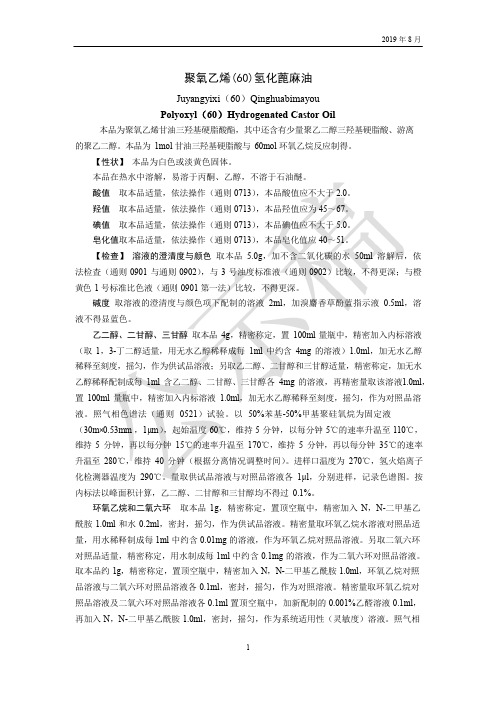
聚氧乙烯(60)氢化蓖麻油Juyangyixi(60)QinghuabimayouPolyoxyl(60)Hydrogenated Castor Oil本品为聚氧乙烯甘油三羟基硬脂酸酯,其中还含有少量聚乙二醇三羟基硬脂酸、游离的聚乙二醇。
本品为1mol 甘油三羟基硬脂酸与60mol 环氧乙烷反应制得。
【性状】本品为白色或淡黄色固体。
本品在热水中溶解,易溶于丙酮、乙醇,不溶于石油醚。
酸值取本品适量,依法操作(通则0713),本品酸值应不大于2.0。
羟值取本品适量,依法操作(通则0713),本品羟值应为45~67。
碘值取本品适量,依法操作(通则0713),本品碘值应不大于5.0。
皂化值取本品适量,依法操作(通则0713),本品皂化值应40~51。
【检查】溶液的澄清度与颜色取本品 5.0g,加不含二氧化碳的水50ml 溶解后,依法检査(通则0901 与通则0902),与3 号浊度标准液(通则0902)比较,不得更深;与橙黄色1 号标准比色液(通则0901 第一法)比较,不得更深。
碱度取溶液的澄清度与颜色项下配制的溶液2ml,加溴麝香草酚蓝指示液0.5ml,溶液不得显蓝色。
乙二醇、二甘醇、三甘醇取本品4g,精密称定,置100ml 量瓶中,精密加入内标溶液(取1,3-丁二醇适量,用无水乙醇稀释成每1ml 中约含4mg 的溶液)1.0ml,加无水乙醇稀释至刻度,摇匀,作为供试品溶液;另取乙二醇、二甘醇和三甘醇适量,精密称定,加无水乙醇稀释配制成每1ml 含乙二醇、二甘醇、三甘醇各4mg 的溶液,再精密量取该溶液1.0ml,置100ml 量瓶中,精密加入内标溶液1.0ml,加无水乙醇稀释至刻度,摇匀,作为对照品溶液。
照气相色谱法(通则0521)试验。
以50%苯基-50%甲基聚硅氧烷为固定液(30m×0.53mm ,1µm),起始温度60℃,维持5 分钟,以每分钟5℃的速率升温至110℃,维持5 分钟,再以每分钟15℃的速率升温至170℃,维持5 分钟,再以每分钟35℃的速率升温至280℃,维持40 分钟(根据分离情况调整时间)。
化妆品原料HLB值表
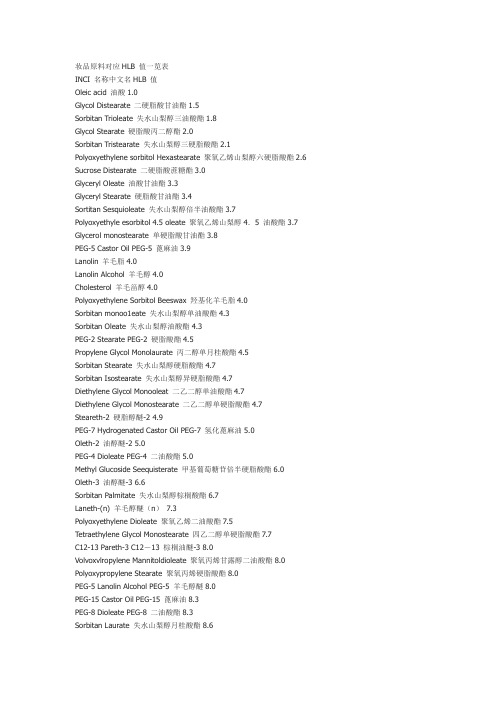
妆品原料对应HLB 值一览表INCI 名称中文名HLB 值Oleic acid 油酸1.0Glycol Distearate 二硬脂酸甘油酯1.5Sorbitan Trioleate 失水山梨醇三油酸酯1.8Glycol Stearate 硬脂酸丙二醇酯2.0Sorbitan Tristearate 失水山梨醇三硬脂酸酯2.1Polyoxyethylene sorbitol Hexastearate 聚氧乙烯山梨醇六硬脂酸酯2.6 Sucrose Distearate 二硬脂酸蔗糖酯3.0Glyceryl Oleate 油酸甘油酯3.3Glyceryl Stearate 硬脂酸甘油酯3.4Sortitan Sesquioleate 失水山梨醇倍半油酸酯3.7Polyoxyethyle esorbitol 4.5 oleate 聚氧乙烯山梨醇4.5 油酸酯3.7 Glycerol monostearate 单硬脂酸甘油酯3.8PEG-5 Castor Oil PEG-5 蓖麻油3.9Lanolin 羊毛脂4.0Lanolin Alcohol 羊毛醇4.0Cholesterol 羊毛甾醇4.0Polyoxyethylene Sorbitol Beeswax 羟基化羊毛脂4.0Sorbitan monoo1eate 失水山梨醇单油酸酯4.3Sorbitan Oleate 失水山梨醇油酸酯4.3PEG-2 Stearate PEG-2 硬脂酸酯4.5Propylene Glycol Monolaurate 丙二醇单月桂酸酯4.5Sorbitan Stearate 失水山梨醇硬脂酸酯4.7Sorbitan Isostearate 失水山梨醇异硬脂酸酯4.7Diethylene Glycol Monooleat 二乙二醇单油酸酯4.7Diethylene Glycol Monostearate 二乙二醇单硬脂酸酯4.7Steareth-2 硬脂醇醚-2 4.9PEG-7 Hydrogenated Castor Oil PEG-7 氢化蓖麻油5.0Oleth-2 油醇醚-2 5.0PEG-4 Dioleate PEG-4 二油酸酯5.0Methyl Glucoside Seequisterate 甲基葡萄糖苷倍半硬脂酸酯6.0 Oleth-3 油醇醚-3 6.6Sorbitan Palmitate 失水山梨醇棕榈酸酯6.7Laneth-(n) 羊毛醇醚(n)7.3Polyoxyethylene Dioleate 聚氧乙烯二油酸酯7.5Tetraethylene Glycol Monostearate 四乙二醇单硬脂酸酯7.7C12-13 Pareth-3 C12-13 棕榈油醚-3 8.0Volvoxvlropylene Mannitoldioleate 聚氧丙烯甘露醇二油酸酯8.0 Polyoxypropylene Stearate 聚氧丙烯硬脂酸酯8.0PEG-5 Lanolin Alcohol PEG-5 羊毛醇醚8.0PEG-15 Castor Oil PEG-15 蓖麻油8.3PEG-8 Dioleate PEG-8 二油酸酯8.3Sorbitan Laurate 失水山梨醇月桂酸酯8.6Oleth-5 油醇醚-5 9.0Polyglyceryl-3 Polyricinoleate 聚甘油-3 聚蓖麻油酸酯9.0Polyoxyethylene Oxypropylene Oleate 聚氧乙烯氧丙烯油酸酯9.0Tetraethylene Glycol Monolaurate 四乙二醇单月桂酸酯9.4C12-13 Pareth-4 C12-13 棕榈油醚-4 9.5Polyoxyethylene Lauryl Ether 聚氧乙烯月桂醚9.5Hoxaethylene Glycol Monostearate 六乙二醇单硬脂酸酯9.6Cocoyl Sarcosine 椰油酰肌氨酸10.0Ceteareth-6 鲸蜡硬脂醇醚-6 10.0PPG-5 Laolin Alcohol PPG-5 羊毛醇醚10.0Ceteth-5 (and) Ceteareth-7 鲸蜡醇醚-5(和)鲸蜡硬脂醇醚-7 10.1 Polyoxyethylene Cetyl Ether 聚氧乙烯十六烷基醚10.3PEG-20 Sorbitan Tristearate PEG-20 失水山梨醇三硬脂酸酯10.5PEG-7Glyceryl Cocoate PEG-7 椰油酸甘油酯10.6Glyceryl Stearate(S/E) 自乳化硬脂酸单甘酯10.8PEG-8 Stearate PEG-8 硬脂酸酯10.8Glyceryl Stearate (and ) PEG 100 Stearate 硬脂酸甘油酯(和)PEG100 硬脂酸酯10.9 Polysorbate 85 PEG-20 失水山梨醇三油酸酯11.0Polyoxyethylene Oxypropylene Oleate 聚氧乙烯氧丙烯油酸酯11.0PEG-8 Glyceryl Laurate PEG-8 月桂甘油酯11.0PEG-8 Stearate PEG-8 硬脂酸酯11.0PEG-29 Castor Oil PEG-29 蓖麻油11.7Alkyl aryl sulfonate 烷基芳基磺酸盐11.7Sucrose Stearate (and) Sucrose Distearate 硬脂酸蔗糖酯(和)二硬脂酸蔗糖酯12.0 Triethanolamine oleate 三乙醇胺油酸酯12.0Oleth-10 油醇醚-10 12.4PEG-35 Castor Oil PEG-35 蓖麻油12.7PEG-40 Hydrogenated Castor Oil PEG-40 氢化蓖麻油13.0PEG-40 Castor Oil PEG-40 蓖麻油13.0PEG-8 Laurate PEG-8 月桂酸酯13.1Lauroyl Sarcosine 月桂酰肌氨酸13.1PEG-6 Capprylic/Capric Glycerides PEG-6 GTCC 甘油酯13.2Ceteareth-12 鲸蜡硬脂醇醚-12 13.4PEG-15 Gluceryl Laurate PEG-15 月桂甘油酯14.0PEG-12 Stearate PEG-12 硬脂酸酯14.0PEG-24 Cholesterol PEG-24 胆甾醇醚14.0PPG-20 Lanolin Alcohol PPG-20 羊毛醇醚14.0PEG-40/45 Hydrogenated Castor Oil PEG-40/45 氢化蓖麻油14.1PEG-60 Almond Glycerides (and)Caprylic/Capric Glycerides PEG-60杏仁油甘油酯(和)PEG-6GTCC 甘油酯14.1Sucrose Stearate 硬脂酸蔗糖酯14.5PEG-60 Hydrogenated Castor Oil PEG-60 氢化蓖麻油14.7Polysorbate 60 PEG-20 失水山梨醇硬脂酸酯14.9Polysorbate 80 PEG-20 失水山梨醇油酸酯15.0PEG-60 Almond Glycerides PEG-60 甜杏仁甘油酯15.0PEG-42 Babassu Glycerides PEG-42 Babassu 甘油酯15.0PEG-60 Evening Primrose Glycerides PEG-60 月见草甘油酯15.0PEG-45 Corn Glycerides PEG-45 玉米油甘油酯15.0PEG-45 Palm Kernel Glycerides PEG-45 棕榈仁油甘油酯15.0PEG-60 Maracuja Glycerides PEG-60 Maracuja 甘油酯15.0PEG-20 Glucamate SS PEG-20 甲基葡萄糖苷倍半油酸酯15.0Steareth-20 硬脂醇醚-20 15.3Oleth-20 油醇醚-20 15.5Steareth-21 硬脂醇醚-21 15.5Polysorbate 40 PEG-20 失水山梨醇棕榈酸酯15.6Ceteareth-20 鲸蜡硬脂醇醚-20 15.7PEG-20 Stearate PEG-20 硬脂酸酯16.0PEG-75 Lanolin PEG-75 羊毛脂16.2Ceteareth-25 鲸蜡硬脂醇醚-25 16.2Polysorbate 20 PEG-20 失水山梨醇月桂酸酯16.7C12-13 Pareth-23 C12-13 棕榈油醚-23 16.7PEG-40 Stearate PEG-40 硬脂酸酯16.7PEG-90 Apricot Kernel Glycerides PEG-90 杏仁甘油酯17.0Sodium Oleate 油酸钠18.0PEG-100 Stearate PEG-100 硬脂酸酯18.8Potassium Oleate 油酸钾20.0N-cetyl N-ethyl morpholinium ethosulfate N-十六烷基-N-乙基吗啉基乙基硫酸钠25-30 Pure Sodium Lauryl Sulfate 纯月桂基硫酸钠40。
氢化蓖麻油(CO-40、PEG-40)
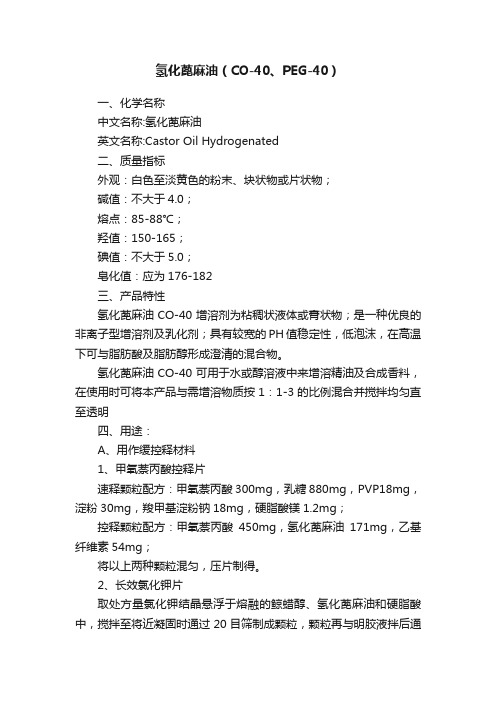
氢化蓖麻油(CO-40、PEG-40)一、化学名称中文名称:氢化蓖麻油英文名称:Castor Oil Hydrogenated二、质量指标外观:白色至淡黄色的粉末、块状物或片状物;碱值:不大于4.0;熔点:85-88℃;羟值:150-165;碘值:不大于5.0;皂化值:应为176-182三、产品特性氢化蓖麻油CO-40增溶剂为粘稠状液体或膏状物;是一种优良的非离子型增溶剂及乳化剂;具有较宽的PH值稳定性,低泡沫,在高温下可与脂肪酸及脂肪醇形成澄清的混合物。
氢化蓖麻油CO-40可用于水或醇溶液中来增溶精油及合成香料,在使用时可将本产品与需增溶物质按1:1-3的比例混合并搅拌均匀直至透明四、用途:A、用作缓控释材料1、甲氧萘丙酸控释片速释颗粒配方:甲氧萘丙酸300mg,乳糖880mg,PVP18mg,淀粉30mg,羧甲基淀粉钠18mg,硬脂酸镁1.2mg;控释颗粒配方:甲氧萘丙酸450mg,氢化蓖麻油171mg,乙基纤维素54mg;将以上两种颗粒混匀,压片制得。
2、长效氯化钾片取处方量氯化钾结晶悬浮于熔融的鲸蜡醇、氢化蓖麻油和硬脂酸中,搅拌至将近凝固时通过20目筛制成颗粒,颗粒再与明胶液拌后通过10目筛,制粒。
室温干燥后加润滑剂压成片芯,最后包糖衣即得。
3、N一(a羟乙基)烟碱酰硝酸酯骨架片取氢化蓖麻油90g,用微粉磨分散成直径1.5µm的微粒,即刻与羟丙基纤维素8g混合,混合物用10%羟丙基纤维素20g与水43g 混合制粒,50℃干燥制得颗粒A;取上述混合物A2.5g,加入主药7.5g,制成颗粒B;取乳糖5.9g,微晶纤维素3g,硬脂酸镁0.1g和主药1g 混合制成颗粒C;将颗粒A、B、C混合压片即得。
4、缓释包衣层材料特定药品需要通过包衣层来达到缓释效果,氢化蓖麻油是常用的缓释材料之一,一般用量为衣层总重量的5.0%-20.0%。
B、用作润滑剂氢化蓖麻油可用作片剂的润滑剂,其润滑作用虽然不及硬脂酸镁,但对少数在压片过程中产生粘冲的片剂,氢化蓖麻油是最好的选择,比如硫酸氢氯吡格雷片就需要采用氢化蓖麻油作为润滑剂。
化妆品原料HLB值一览表
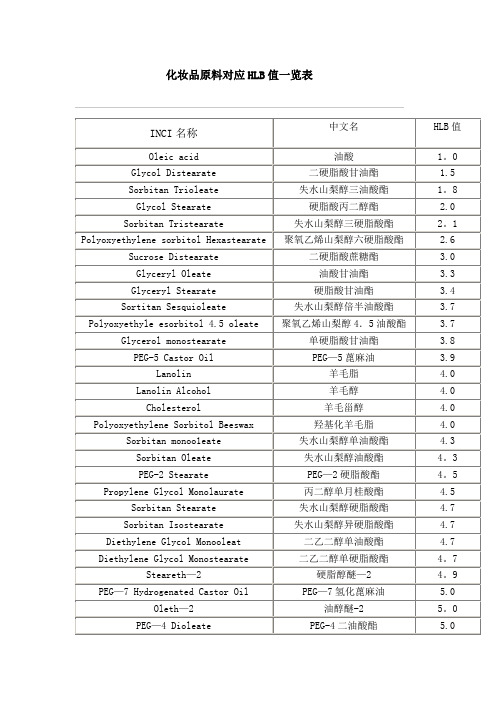
14.0
PEG—12 Stearate
PEG-12硬脂酸酯
14.0
PEG—24 Cholesterol
PEG-24胆甾醇醚
14.0
PPG-20 Lanolin Alcohol
PPG-20羊毛醇醚
14.0
PEG—40/45 Hydrogenated Castor Oil
PEG-40/45氢化蓖麻油
14。7
Polysorbate 60
PEG—20失水山梨醇硬脂酸酯
14.9
Polysorbate 80
PEG-20失水山梨醇油酸酯
15.0
PEG—60 Almond Glycerides
PEG-60甜杏仁甘油酯
15。0
PEG-42 Babassu Glycerides
PEG-42 Babassu 甘油酯
14。1
PEG—60 Almond Glycerides (and) Caprylic/Capric Glycerides
PEG-60杏仁油甘油酯(和)PEG—6GTCC 甘油酯
14.1
Sucrose Stearate
硬脂酸蔗糖酯
14。5
PEG-60 Hydrogenated Castor Oil
PEG-60氢化蓖麻油
15.0
PEG-60 Evening Primrose Glycerides
PEG—60月见草甘油酯
15。0
PEG—45 Corn Glycerides
PEG-45玉米油甘油酯
15.0
PEG-45 Palm Kernel Glycerides
PEG—45棕榈仁油甘油酯
15.0
Cremophor RH40_Data sheet_CN
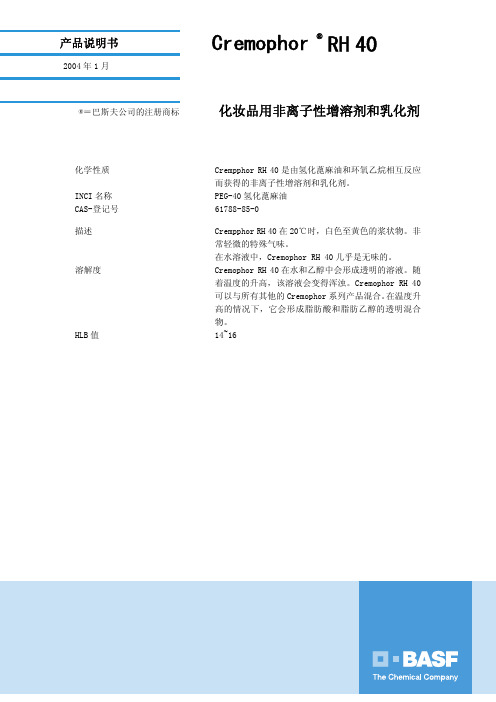
Cremophor RH 40 可以增溶水和乙醇-水混合物中的精油 和芳香油。与其他增溶剂相比,Cremophor RH 40 使用 浓度相对较低。 作为一种乳化剂,Cremophor RH 40 也是非常适合的。 它能够乳化各种各样的疏水物质,例如,脂肪酸、脂肪 醇、维生素和活性化合物。
在室温条件下,原装的密封容器储存于干燥处, Cremophor RH 40 保质期为二年。 Cremophor RH 40 所使用的生产方法确保是无菌的。如 果容器被反复打开的话,那么,微生物就会在产品中生 长,尤其是在所使用的设备是有菌的时候。
备注 上述产品说明、图样、数据及其资料仅供您参考,尽管我们是诚实地提供并确信其是准确的。 由于有很多因素可能影响到对产品的实际处理或应用/使用,我们建议您在使用之前进行必 要测试,以确定相关产品符合您特定的目的。就所述产品或图样,或数据或资料的使用是否 会侵犯其他方的知识产权,我们不做任何形式的、明示或默示的担保和保证,包括产品产品 可销售性或适合特定用途方面的保证。在任何情况下,上述所提供的产品说明、图样、数据 和资料均不得视为我方销售条款或条件的一部分。此外,您应特别地理解和同意,巴斯夫在 此所提供的说明、图样、数据和资料纯为无偿提供,巴斯夫对于说明、图样、数据和资料的 提供,以及由此产生的结果,不承担任何义务或责任,您对以上提供的说明、图样、数据及 其资料的接受自行负责。
产品说明书
2004 年 1 月
Cremophor ® RH 40
®=巴斯夫公司的注册商标
化妆品用非离子性增溶剂和乳化剂
化学性质 INCI 名称 CAS-登记号 描述 溶解度
HLB 值
Crempphor RH 40 是由氢化蓖麻油和环氧乙烷相互反应 而获得的非离子性增溶剂和乳化剂。 PEG-40 氢化蓖麻油 61788-85-0
聚酰胺改性氢化蓖麻油化学品安全技术说明书 (MSDS)

聚酰胺改性氢化蓖麻油化学品安全技术说明书 (MSDS)第一部分:化学品名称1.1 化学品中文名称:微粉化蜡1.2 化学品英文名称:CRAYVALLAC MT1.3 中文名称2:1.4 分子式:1.5 分子量:第二部分:成分/组成信息2.1 主要成分:2.2 含量:2.3 CAS No.第三部分:危险性概述3.1 危险性类别:其粉尘与空气可形成爆炸性混合物3.2 侵入途径:吸入3.3 健康危害:不要吸入粉尘第四部分:急救措施4.1 皮肤接触:用肥皂及清水彻底冲洗皮肤4.2 眼睛接触:立即翻开上下眼睑,用大量清水冲洗:不准使用溶剂:如有引起炎症或疼痛,请立即就医4.3 吸入:迅速将处于危险区的人员脱离现场至空气新鲜处。
如有呼吸困难,请就医。
4.4 食入:如果吞咽,请立即就医,同时将盛装此物的容器或标签给医生第五部分:消防措施5.1 危险特性:该化学品在火中会熔化,如果使用高压水枪,可能导致污染源扩散5.2 有害燃烧产物:一氧化碳,二氧化碳和氧化氮的混合有毒气体5.3 灭火方法:可用喷雾水,干粉、泡沫、二氧化碳扑救;请勿使用高压水枪灭火第六部分:泄漏应急处理6.1 应急处理:将泄漏物收集在密闭容器内,运至废物处理场所根据当地法规处理。
避免产生灰尘以及避免扬尘。
避免注入下水道:防止进入周边环境中第七部分:操作处置与储存7.1 操作注意事项:远离火源、火种;操作过程中避免产生粉尘;采取措施防止静电7.2 储存注意事项: 储存于阴凉、干燥、通风库房,保持包装容器密封;储存于原始包装容器中;远离热源、火种;保持接地第八部分:接触控制/个体防护8.1 职业接触限值:吸入粉尘量(8小时)10mg/m38.2 监测方法:8.3 工程控制:生产过程中加强通风,加强过程控制,降低空气中该物质的含量低于容许暴露浓度值;提供洗眼器8.4 呼吸系统防护:佩戴防尘口罩8.5 眼睛防护:如果有接触眼睛的危险,请佩戴防尘安全眼镜(佩戴经过认证的安全眼镜)8.6 身体防护:8.7 手防护:使用防护手套(氯丁橡胶)8.8 其他防护:工作现场禁止吸烟;接触该物质时勿进食或饮水;下班、吃饭、吸烟和上洗手间前,洗净手和脸;如果衣服被弄脏,迅速脱下;如果皮肤被弄脏,迅速用肥皂和水清洗并使用适当的润肤膏第九部分:理化特性9.1 外观与性状:灰白色粉末状9.2 熔点(°C):130-1409.3 沸点(°C):9.4 液碱相对密度:9.5 蒸气密度 (空气=1):9.6 饱和蒸气压 (kPa):9.7 燃烧热 (kJ/mol):9.8 临界温度(°C):9.9 临界压力 (MPa):9.10 辛醇/水分配系数:9.11 引燃温度(°C):9.12 闪点(°C):>659.13 爆炸上限 %(V/V):9.14 爆炸下限 %(V/V):9.15 溶解性:不溶于水但可溶于大多数有机溶剂9.16 主要用途:第十部分:稳定性和反应活性10.1 稳定性:在一般储存条件下稳定10.2 禁忌物:10.3 避免接触的条件:避免热源:避免接触酸和氧化剂10.4 聚合危害:10.5 分解产物:在有火源处会产生一氧化碳,二氧化碳和氧化氮的混合有毒气体第十一部分:毒理学资料11.1 急性毒性:粉尘可能刺激呼吸系统或肺;进入眼睛可能导致刺痛11.2 亚急性和慢性毒性:11.3 刺激性:第十二部分:生态学资料12.1 生态毒理毒性:12.2 生物降解性:12.3 非生物降解性:12.4 生物富集或生物积累性:12.5 其它有害作用:使用时保持良好的习惯做法,避免直接置于周围环境第十三部分:废弃处置13.1 废弃物性质:13.2 废弃处置方法:根据地方有关法规的要求处置,不要直接倒入下水道或周围环境,倒入指定的废物收集点13.3 废弃注意事项:第十四部分:运输信息14.1 危险货物编号:14.2 UN编号:14.3 包装标志:14.4 包装类别:14.5 包装方法:14.6 运输注意事项:该产品对运输安全没有特殊要求第十五部分:法规信息法规信息:危险警语:没定义安全警语:S-22不要吸入粉尘S-33 采取预防措施防止静电放电S-37/39佩戴合适的手套和防护眼镜英国法规参照:Chemicals(Hazard Information£Packaging )(CHIP)Regulations 2000欧盟法规:Commission Directive2004/73/EC of 29 April2004 adapting to technical progress forThe 29th time Council Directive 67/548/EECOn the approximation of the laws, regulationsAnd administrative provisions relating toThe classification, packaging and labelingOf danagerous substances(official JournalL 216-16/06/2004).Dangerous preparations:Directive 1999/45/EC amended by Directive2001/60/EC-0JEC L226-22/08/2001.Directive91/155/EEC amended by Directive 93/112/EECAnd Directive 2001/58/EC:Safety data sheets第十六部分:其他信息16.1 参考文献:16.2 其他信息:该资料仅仅适用于符合GRAYVALLEY产品规格的产品;在配方中使用该产品时,使用者必须做到上述提到的安全措施以保障不出现新的危险;该资料所包含的信息是在诚信的基础上基于我们在发布该信息时对产品的了解;如果该产品用非所用,可能存在风险;以健康和安全为目的时,该信息可使用和拷贝;对相关法律和法规的参考不尽详细,可以考虑其他相适用的规章制度;使用者在使用,储存和搬运过程中有责任参考现存的相关法规;同时,使用者还有责任将此“化学品安全技术说明书”上关于对健康,安全,环境保护的相关信息告知所有参与储存和搬运过程中的人员。
化妆品原料HLB值一览表
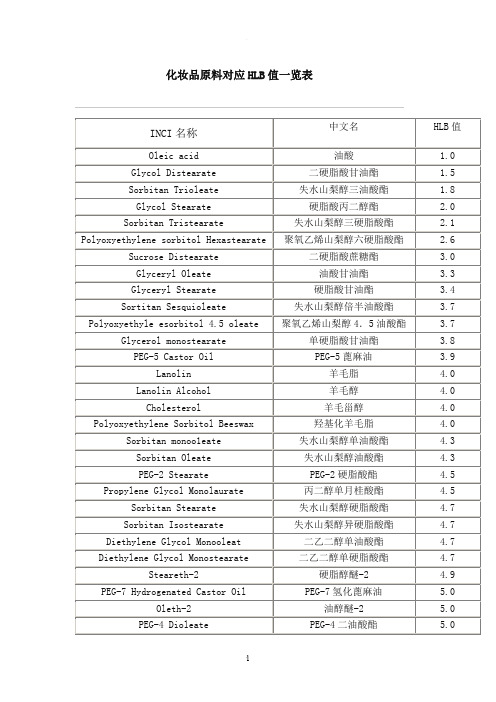
9.0
Tetraethylene Glycol Monolaurate
四乙二醇单月桂酸酯
9.4
C12-13 Pareth-4
C12-13棕榈油醚-4
9.5
Polyoxyethylene Lauryl Ether
聚氧乙烯月桂醚
9.5
Hoxaethylene Glycol Monostearate
10.8
Glyceryl Stearate (and ) PEG 100 Stearate
硬脂酸甘油酯(和)PEG100硬脂酸酯
10.9
Polysorbate 85
PEG-20失水山梨醇三油酸酯
11.0
Polyoxyethylene Oxypropylene Oleate
聚氧乙烯氧丙烯油酸酯
11.0
4.7
Steareth-2
硬脂醇醚-2
4.9
PEG-7 Hydrogenated Castor Oil
PEG-7氢化蓖麻油
5.0
Oleth-2
油醇醚-2
5.0
PEG-4 Dioleate
PEG-4二油酸酯
5.0
Methyl Glucoside Seequisterate
甲基葡萄糖苷倍半硬脂酸酯
6.0
PEG-40蓖麻油
13.0
PEG-8 Laurate
PEG-8月桂酸酯
13.1
Lauroyl Sarcosine
月桂酰肌氨酸
13.1
PEG-6 Capprylic/Capric Glycerides
PEG-6 GTCC甘油酯
13.2
Ceteareth-12
甘油丙氧基三缩水甘油基醚
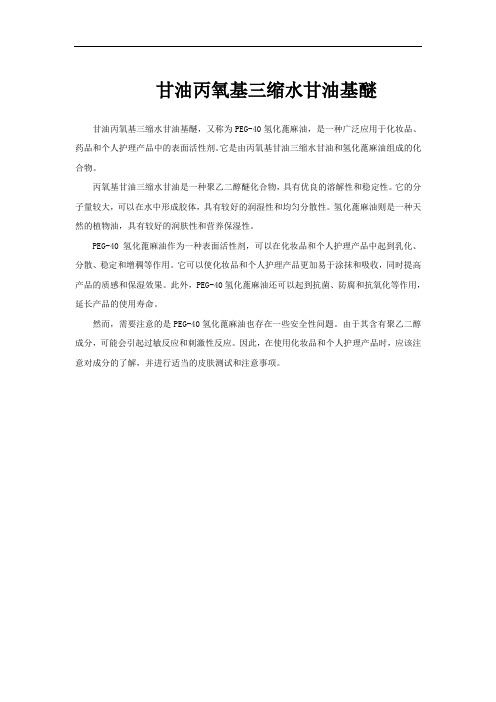
甘油丙氧基三缩水甘油基醚
甘油丙氧基三缩水甘油基醚,又称为PEG-40氢化蓖麻油,是一种广泛应用于化妆品、药品和个人护理产品中的表面活性剂。
它是由丙氧基甘油三缩水甘油和氢化蓖麻油组成的化合物。
丙氧基甘油三缩水甘油是一种聚乙二醇醚化合物,具有优良的溶解性和稳定性。
它的分子量较大,可以在水中形成胶体,具有较好的润湿性和均匀分散性。
氢化蓖麻油则是一种天然的植物油,具有较好的润肤性和营养保湿性。
PEG-40氢化蓖麻油作为一种表面活性剂,可以在化妆品和个人护理产品中起到乳化、分散、稳定和增稠等作用。
它可以使化妆品和个人护理产品更加易于涂抹和吸收,同时提高产品的质感和保湿效果。
此外,PEG-40氢化蓖麻油还可以起到抗菌、防腐和抗氧化等作用,延长产品的使用寿命。
然而,需要注意的是PEG-40氢化蓖麻油也存在一些安全性问题。
由于其含有聚乙二醇成分,可能会引起过敏反应和刺激性反应。
因此,在使用化妆品和个人护理产品时,应该注意对成分的了解,并进行适当的皮肤测试和注意事项。
- 1、下载文档前请自行甄别文档内容的完整性,平台不提供额外的编辑、内容补充、找答案等附加服务。
- 2、"仅部分预览"的文档,不可在线预览部分如存在完整性等问题,可反馈申请退款(可完整预览的文档不适用该条件!)。
- 3、如文档侵犯您的权益,请联系客服反馈,我们会尽快为您处理(人工客服工作时间:9:00-18:30)。
NF 30Official Monographs / Polyoxyl 1917C: To a solution (1 in 20) add bromine TS, dropwise: the Congealing temperature 〈651〉: between 37° and 47°.bromine is decolorized.Acid value 〈401〉: not more than 2.Specific gravity 〈841〉: between 1.05 and 1.06.Hydroxyl value 〈401〉: between 25 and 40.Viscosity 〈911〉: between 600 and 850 centipoises at 25°, a Saponification value 〈401〉: between 25 and 35.capillary viscometer being used.Water, Method I 〈921〉: not more than 3.0%.Acid value 〈401〉: not more than 2.0.Heavy metals, Method II 〈231〉: 0.001%.Hydroxyl value 〈401〉: between 65 and 80.Free polyethylene glycols—Transfer about 6g, accurately Iodine value 〈401〉: between 25 and 35.weighed, to a 500-mL separator containing 50 mL of ethyl ace-Saponification value 〈401〉: between 60 and 75.tate. Dissolve completely, then add 50 mL of sodium chloride solution (29 in 100), shake vigorously for 2 minutes, and allow Water, Method I 〈921〉: not more than 3.0%.to separate for 15 minutes. If separation is incomplete, carefully Residue on ignition 〈281〉: not more than 0.3%.insert the separator into the well of a steam bath for short time Heavy metals, Method II 〈231〉: 0.001%.intervals. Repeat this technique as many times as necessary to ensure the complete separation of the two phases. Cool, and drain the lower, aqueous, phase into a second 500-mLseparator, and extract the upper layer with a second 50-mL portion of sodium chloride solution (29 in 100). Repeat the Polyoxyl 40 Hydrogenated Castor Oilseparation as before, including the steam bath technique to en-hance complete separation. To the combined aqueous layers » Polyoxyl 40 Hydrogenated Castor Oil contains add 50 mL of ethyl acetate, shake vigorously for 2 minutes, and mainly the tri-hydroxystearate ester of ethoxy-allow to separate as before. Drain the lower, aqueous phase into a third 500-mL separator, and extract it with two 50-mL lated glycerol, with smaller amounts of polyethyl-portions of chloroform, by shaking for 2 minutes each time.ene glycol tri-hydroxystearate and of the corre-Repeat the steam bath technique to ensure complete separa-sponding free glycols. It results from the reaction tion. Evaporate the combined chloroform extracts in a 150-mL of glycerol tri-hydroxystearate with about 40 to beaker on a steam bath, with the aid of a stream of nitrogen,to apparent dryness. Redissolve in about 15 mL of chloroform,45 moles of ethylene oxide.and transfer to a filter, collecting the filtrate in a 150-mLPackaging and storage—Preserve in tight containers.beaker. Rinse the funnel with several small portions of chloro-form, and evaporate the combined filtrate and rinsings, as de-Identification—scribed above, until no odor of chloroform or ethyl acetate is A: Dissolve about 0.1 g in 1 mL of water, add 9 mL of perceptible. Dry in vacuum at 60° for 1 hour. Cool in a desicca-sodium chloride solution (1 in 20), and heat in a water bath:tor, and weigh: not less than 17% and not more than 27% of the solution becomes turbid at a temperature between 70° and free polyethylene glycols is found.85°.B: Dissolve about 0.1 g in 10 mL of alcoholic potassium hydroxide TS, boil for about 3 minutes, and evaporate to dry-ness. Mix the residue with 5 mL of water: it dissolves, yielding a clear solution. Add a few drops of glacial acetic acid: a white Polyoxyl Lauryl Etherprecipitate is formed.Congealing temperature 〈651〉: between 16° and 26°.CH 3(CH 2)11(OCH 2CH 2)n OH, n = 3–23Acid value 〈401〉: not more than 2.0.Polyethylene glycol monolauryl ether [9002-92-0].Hydroxyl value 〈401〉: between 60 and 80.DEFINITIONIodine value 〈401〉: not more than 2.0.Polyoxyl Lauryl Ether is a mixture of the monolauryl ethers of Saponification value 〈401〉: between 45 and 69.mixed polyethylene glycols, the average polymer length be-Water, Method I 〈921〉: not more than 3.0%.ing equivalent to NLT 3 and NMT 23 oxyethylene units(nominal value). It contains various amounts of free lauryl al-Residue on ignition 〈281〉: not more than 0.3%.cohol, and it may contain some free polyethylene glycols.Heavy metals, Method II 〈231〉: 0.001%.IDENTIFICATION•A . I NFRARED A BSORPTION 〈197F 〉Sample: Use a thin film of melted Polyoxyl Lauryl Ether if the material is a solid.Polyoxyl 40 StearateAcceptance criteria: Meets the requirements Poly(oxy-1,2-ethanediyl), α-hydro-ω-hydroxy-, octade-•B . P ROCEDURE canoate.Sample: 0.1 gPolyethylene glycol monostearate [9004-99-3].Analysis: Dissolve or disperse the Sample in 5 mL of alcohol,and add 10 mL of diluted hydrochloric acid, 5 mL of barium » Polyoxyl 40 Stearate is a mixture of the mono-chloride TS, and 10 mL of phosphomolybdic acid solution (1esters and di-esters of Stearic Acid or Purified Ste-in 10).Acceptance criteria: A precipitate is formed.aric Acid with mixed polyoxyethylene diols, the •C . It meets the requirements of the test for Fats and Fixed average polymer length being equivalent to Oil, Hydroxyl Values 〈401〉.about 40 oxyethylene units.IMPURITIESPackaging and storage—Preserve in tight anic Impurities•P ROCEDURE : L IMIT OF F REE E THYLENE O XIDE AND D IOXANEUSP Reference standards 〈11〉—Analysis: Proceed as directed in Ethylene Oxide and Diox-USP Polyoxyl 40 Stearate RSane, Method I 〈228〉.Identification, Infrared Absorption 〈197M 〉, on undried specimen.Official from May 1, 2012Copyright (c) 2011 The United States Pharmacopeial Convention. All rights reserved.Accessed from 128.83.63.20 by nEwp0rt1 on Tue Nov 29 23:32:55 EST 2011。
